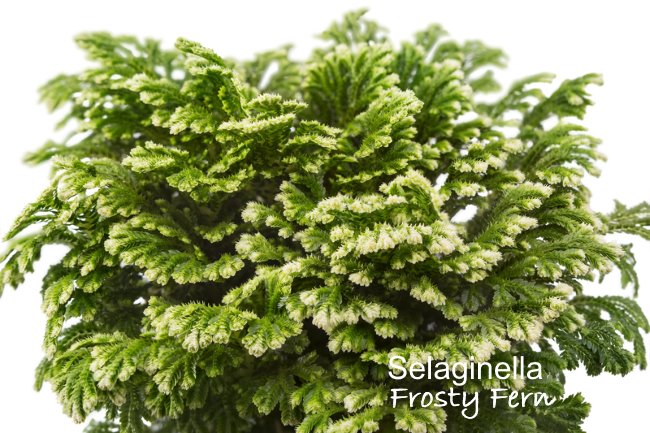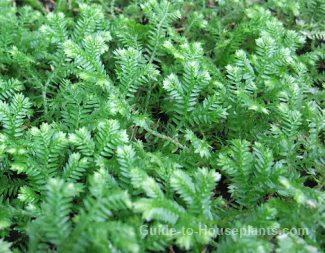Clubmoss - A Spreading Terrarium Plant
I'll just say it up front. Clubmoss requires high humidity, so unless you live in the tropics, you'll want to boost the humidity around this plant to keep it lush and green.
Clubmoss makes a handsome addition to a terrarium grouping. Here, you'll find out how to care for Selaginella as an indoor plant. You'll get help for watering and fertilizing, how to keep it from turning brown, plus how to propagate this unusual houseplant.
 White-tipped foliage gives this variety the name Frosty Fern. Photo ©Vladimir Konjushenko
White-tipped foliage gives this variety the name Frosty Fern. Photo ©Vladimir KonjushenkoGet to Know Clubmoss Plants
Known botanically as Selaginella kraussiana and other spp., this South African native offers lots of varieties to choose from.
How big does it get? Selaginella will reach a height of about 2" to 6", depending on the species. It spreads out rather than up. You can keep any variety small by pruning it back.
Its mounding habit is made up of creeping stems that spread quickly across the soil, forming a dense mat of foliage. Selaginella adds a wonderful texture to any plant grouping. Its unusual, branching foliage gives it another common name, Spike Moss.
Selaginella Varieties
Many types of Selaginella are available for sale. Variegated and gold varieties will add beautiful contrast to your collection.
Golden-green Selaginella kraussiana 'Aurea' is a popular cultivar. 'Variegata' has creamy white tips, giving it the common name, Frosty Fern. Tiny-leafed 'Brownii' forms a tight mass that spreads out, rather than up.
Want something truly unusual? Selaginella lepidophylla is a desert plant, known as the Resurrection Fern. It's sold completely dried out and rolled up in a ball, looking like dead foliage. But once you soak it in water, you can watch the ball unfurl to a lush green rosette.
Clubmoss Problems, Solutions and Answers
Brown, shriveled leaves are the result of dry air. Put this humidity-loving plant in a terrarium or raise the humidity around it to give it the moist air it craves.
Prune it back in spring to keep this spreading plant under control. You can prune up to half of the plant, if you want. It's a vigorous grower and will fill out again. Don't toss out those stem cuttings, either -- they root easily for more plants.
Repot in spring when it outgrows its pot. Clubmoss has shallow roots, so a shallow pot will do. Use a pot with a drainage hole to prevent soggy soil, which will lead to root rot. Want to use a decorative pot without drainage holes? Use it as a cachepot. Just slip a plain nursery pot into the cachepot. I put small rocks in the bottom of cachepots to keep the inner pot above the drainage water.
Is Selaginella poisonous? No. According to the ASPCA, it's safe around cats and dogs.
Growing Tips for Clubmoss

Light: Moderate light. Keep it out of direct sunlight, which can scorch foliage.
Water: Aim to keep the potting medium lightly moist at all times, but don't allow the plant to sit in water. It's a good idea to use a pot with a drainage hole to prevent root rot. Remember to always use room-temperature water for your tropical houseplants because cold water is a shock to them.
Humidity: High -- above 50% relative humidity. Indoor air can become extremely dry during the winter months. Use a humidity monitor, rather than guess -- it's the only sure way to know whether the air is too dry for your houseplants. If the air is dry, mist the plant every morning with room-temperature water or stand the pot on a tray of wet pebbles. Keep clubmoss in a terrarium to maintain humidity around it, near a cool-mist room humidifier or in a Wardian case.
Temperature: Average room temperatures (65-75°F/18-24°C). Try to maintain a steady temp -- Selaginella doesn't like it too cold or too hot, especially drafts. Keep this plant away from entryways and heat/AC vents.
Soil: Peat moss-based potting mix with perlite or horticultural sand added for good drainage.
Fertilizer: Selaginella is not a heavy feeder. Feed monthly spring through fall with a balanced (such as 10-10-10 NPK) liquid fertilizer, at half strength. Add fertilizer while watering to prevent burning the roots.
Propagation: Division or stem cuttings. Take stem tip cuttings in spring or summer. Just give the stems contact with the soil and they'll take root as they grow, forming a spreading mat.


